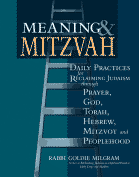|
He took the package from my hands and drew the objects out tenderly. "I have not used these since the beginning of the war," is what I recall him to have said. He continued: "I used to keep kosher, say the Shema every night, and pray with these every morning." I regarded this latter statement with surprise. We went to Friday night synagogue together occasionally, lit candles, had a chanukkah menorah and a seder, not much else.
"These are called tefillin," he explained. "They contain hand-written scrolls with verses from the Torah about love. During my term of service in World War II I lost my sense of a loving God. I stopped keeping kosher, praying and using these." He was in the Signal Corps, I later learned. He helped lay communications lines which found him given leave to the nearest town, which was the just liberated site of Auschwitz. He was gravely injured, evacuated and spent six years in the hospital, wounded for life, leg crushed, marrow infected. His continuing survival remains a modern miracle.
My father wandered off with the tefillin. We did not discuss them again.
A year later my yiddish-speaking Grandfather Benjamin came for an extended visit. Every morning he would go to the dining room and mumble for an hour, putting on a similar set of boxes and straps (his boxes are much tinier than my father's) and a tallit prayer shawl. My mother says at first I would watch him intently and after some weeks she found me beside him everyday, with a ribbon wrapped around my arm and a towel over my shoulders.
One day "Pop Pop" turned to me for the first time in the midst of his prayer, took off his tefillin and wound them properly onto me, uttering urgently in to me incomprehensible Yiddish. He went home the next day and enter a "rest home" not long thereafter. Often I've wondered, given my pixie hair cut in those times, did he think I was a little boy? Or sensing his mortality and knowing I was the only family member drawn to Judaism religiously, had he made a strategic decision?
Pop Pop's tefillin became my own. One day they even returned to the Ukraine with me, their and his place of origin. The spiral of spirit continues.
At an Ohalah Conference (Association of rabbis and cantors dedicated to cultivating Jewish spirituality) my friend and roommate, Rabbi Shefa Gold, taught me how to meditate on sacred relationships while putting on tefillin. One of the most powerful of the tefillin prayers is from the prophet Hosea. The same prayer often used as a commitment statement at Jewish weddings. Here is a weaving of Shefa's interpretation (bold print), with my own [brackets]:
V'eirastikh li l’olam
I betroth you to me forever.
[We are in this together]
V’eirastikh li b’tzedek
I will betroth you to me equitably.
[We will share the challenges]
U’v’mishpat
and with impeccability
[I will stay with you to get it right]
U’v’khessed
and with lovingkindness
[I will care for you]
U’v’rakhamim
and with compassion
[I want to hear your pain, your joy
to strive to understand]
v’eirastikh li b’emunah
I will betroth you to me in faith
[I will be there for you]
v’yahdaht et Adonai.
So that you will know God.
[So that you will experience what is only possible through relationship.]
While putting tefillin on, one does seven windings on the arm. Three more windings are on the ring finger. And all together the windings on the hand actually shape the Hebrew letter "shin", for Shadai, a name for God as Nurturer (shadaii-m are breasts or hills). Thus, tefillin practice turns out to be a powerful ritual of commitment.
With or without the actual tefillin, you might try this:
1) Do your tefillin hand windings and address each part of the verse set above to God.
2) Do the verse set again, checking each of the statements in regard to your relationship with your committed partner, friend, parent or child.
3) Do the verse set again, do it about your relationship to yourself.
4) Repeat the verse set and again address each part to your relationship with God.
What do you notice having done this?
What changes for you with each step?
If a friend, partner or relative of yours lays tefillin also, try putting on your tefillin and doing this spiritual experiment together!

Learn more about Jewish prayer
from a spiritual perspective in
Meaning & Mitzvah: Daily Practices
for Reclaiming Judaism
through Prayer, God, Torah, Hebrew,
Mitzvot and Peoplehood
by Rabbi Dr. Goldie Milgram
|